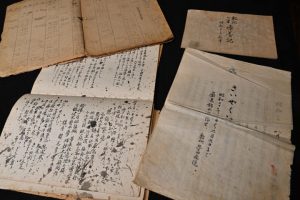Documenting Hiroshima 80 years after A-bombing: Newly discovered manuscript of ‘Chronicle of the disaster,’ written by Ichiro Moritaki
Jan. 1, 2025
Raw, vivid memories of A-bombing recorded daily, serve as origin of his rejection of nuclear weapons
by Kyosuke Mizukawa Senior Staff Writer and Yumi Kanazaki, Staff Writer
The existence of the original manuscript for the journal Saiyaku-ki (in English, ‘Chronicle of the disaster’) written by Ichiro Moritaki, an A-bomb survivor involved in the founding of the Japan Confederation of A- and H-Bomb Sufferers Organizations (Nihon Hidankyo) who died in 1994 at the age of 92, has been confirmed. Mr. Moritaki led the A-bomb survivors’ movement as well as the movement to ban atomic and hydrogen bombs. He wrote the journal starting on August 6, 1945, as a daily record of his experiences in the atomic bombing. Due to his injured right eye, he had others take dictation of his oral descriptions. The journal is a document of the highest-quality, vividly recording the “disaster” resulting from the dropping of the atomic bomb by the U.S. military, based on his raw and vivid memories at that time.
Mr. Moritaki was a teacher at Hiroshima Higher Normal School (present-day Hiroshima University) and experienced the atomic bombing at a shipyard in the area of Eba-cho (in Hiroshima City’s present-day Naka Ward), located around four kilometers from the hypocenter. At the time, he was supervising a group of students from his school who had been mobilized for work. A glass shard blown by the bomb’s blast hit his right eye, resulting in the loss of sight in that eye.
His journal, which begins on August 6 and covers the time until September 9, is inscribed on 20 sheets of letter paper. “Because I sensed my right eye was injured, I dropped to the ground immediately. Along with the enormous blast, a massive amount of materials fell on me,” a description he wrote in his journal entry dated August 6. He was bleeding from his right eye, causing him severe pain.
In an entry dated August 8, involving his visit to the Hiroshima Red Cross Hospital (in Hiroshima’s present-day Naka Ward) to undergo treatment, he wrote in his journal, “There were corpses, dying victims, groans, and unbearable odors.” He added, “The sounds of victims moaning was intense,” as he sensed the tragedy with smells and sounds. With the injury not only to his right eye but also the risk of sympathetic ophthalmia inflammation in his left eye, he inscribed Hiroshima’s circumstances in his mind, using such descriptions as, “Bearing the pain, I managed to open my left eye and glance at the city, which revealed a desolate, scorched wasteland.”
After his students took dictation for him until August 14, Mr. Moritaki started writing the journal himself on August 15, keeping it by his side. His account of the period until August 14 was incorporated into the publication Hiroshima Prefectural History: A-bombing Documents, published in 1972, leading to his journal’s existence becoming known to the public.
After the end of the war, while working as a professor at Hiroshima University, Mr. Moritaki served in such posts as chair of the Hiroshima Prefectural Confederation of A-bomb Sufferers Organizations (Hiroshima Hidankyo) and as co-chair of Nihon Hidankyo. He also assumed the position of chair of the Japan Congress Against A- and H-Bombs. He specialized in ethics and left behind such profound words as “humanity cannot coexist with nuclear weapons.” Each time a nuclear test was conducted, he would stage a sit-in before the Cenotaph for the A-bomb Victims, located in Peace Memorial Park (in Hiroshima’s Naka Ward). He was a symbolic presence in Hiroshima.
Mr. Moritaki’s second daughter, Haruko, 85, a resident of Hiroshima’s Saeki Ward, said that of all his writings, the whereabouts of his work during the war, his journal Saiyaku-ki (‘Chronicle of the disaster’), and Shikiji no Sato Ryoyo-ki (‘Chronicle of healing in the town of Shikiji’), which he wrote starting in September 1945 until the following year while hospitalized at an ophthalmic clinic in the northern part of Hiroshima Prefecture, had not been identified since his death. Along with a record of his treatment immediately after the bombing kept by his students, all the materials were found in his home.
Post-bombing records are precious
Comments by Satoru Ubuki, former professor at Hiroshima Jogakuin University who studies A-bomb survivors’ personal accounts of the atomic bombings — Above all, Mr. Moritaki’s Saiyaku-ki (‘Chronicle of the disaster’) is precious as a record written right after the atomic bombing. The material gives a sense of the great responsibility he felt as a teacher working to pass on to future generations information about the situation at that time. Mr. Moritaki has also left behind post-war journals and other materials. I therefore anticipate that, based on his materials, further research can be conducted from a variety of perspectives, including that of the A-bomb survivors’ movement.
(Originally published on January 1, 2025)








